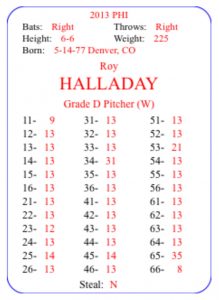
You know you’re getting old when first-ballot Baseball Hall of Famers were born five years after you. How did that happen? It seems like only yesterday when Hall of Famers were old men. Unfortunately, Roy Halladay didn’t get to become an old man or stand at the podium this coming summer to give his induction speech. His tragic death is an unfortunate addition to the story of baseball, joining fellow Hall of Famers Ed Delahanty, Addie Joss, Ross Youngs, and Roberto Clemente as players who died unnaturally young. Certainly, it’s not just Hall of Famers who succumb to tragedy. It seems like every generation has players who perish in sad circumstances. The names trigger their stories: Ray Chapman, Lyman Bostock, Thurman Munson, Oscar Taveras, and Jose Fernandez, just to name a few.
There are many things to admire about Roy Halladay, however I admired his old-school tenacity and durability most. Roy reminded me of the players I grew up watching, guys like Jack Morris, Orel Hershiser, Dave Stewart, and Roger Clemens. Halladay also reminded me of pitchers who I saw at the ends of their careers, like Nolan Ryan, Steve Carlton, and Tom Seaver.
Roy Halladay was a workhorse. Seven times he led the league in complete games, and four times he led in innings pitched. For his 16-year career, Halladay averaged 232 innings pitched a season. In postmodern baseball, that’s a remarkable figure. Doc was an ace of aces, and if you were lucky enough to have him on your APBA league team from 2002-2011, you were set at the top of your rotation because you had the most valuable pitcher in baseball.
Early in his career with the Toronto Blue Jays, Doc dominated as a sinkerball pitcher. In the second half of his career with the Philadelphia Phillies, Halladay learned the splitter and produced some impressive strikeout numbers. In fortunately, shoulder issues plagued Roy late in his career and forced his early retirement at on 36 years old. As you might expect, his final APBA card resulted in a D rating.
| Split | W | L | W-L% | ERA | G | GS | CG | SV | IP | H | R | ER | HR | BB | SO | HBP | WP | BF | WHIP | SO9 | SO/W |
|---|---|---|---|---|---|---|---|---|---|---|---|---|---|---|---|---|---|---|---|---|---|
| 2013 Totals | 4 | 5 | .444 | 6.82 | 13 | 13 | 1 | 0 | 62.0 | 55 | 48 | 47 | 12 | 36 | 51 | 10 | 4 | 282 | 1.468 | 7.4 | 1.42 |
Roy Halladay is probably best known for throwing the second postseason no-hitter in MLB history in 2010 after throwing a perfect game earlier in the season. However, Doc was also just the fifth pitcher to win the Cy Young Award in both leagues. More than anything, his career represents what a postmodern Hall of Fame pitcher looks like: 10+ years of dominance, but no significant career milestones. Halladay didn’t have 300 wins, heck he barely had 200 (203). He never reached 3,000 strikeouts (2,117) or even 3,000 innings pitched (2,749). However, he was clutch when it was needed and a workhorse by modern standards. Doc Halladay’s first ballot induction bodes well for pitchers like Justin Verlander, Max Scherzer, and Felix Hernandez.



